
The Last Supper is the final meal that, in the Gospel accounts, Jesus shared with his apostles in Jerusalem before his crucifixion. The Last Supper is commemorated by Christians especially on Holy Thursday. The Last Supper provides the scriptural basis for the Eucharist, also known as "Holy Communion" or "The Lord's Supper".

The Museo del Prado, officially known as Museo Nacional del Prado, is the main Spanish national art museum, located in central Madrid. It houses collections of European art, dating from the 12th century to the early 20th century, based on the former Spanish royal collection, and the single best collection of Spanish art. Founded as a museum of paintings and sculpture in 1819, it also contains important collections of other types of works. The numerous works by Francisco Goya, the single most extensively represented artist, as well as by Hieronymus Bosch, El Greco, Peter Paul Rubens, Titian, and Diego Velázquez, are some of the highlights of the collection. Velázquez and his keen eye and sensibility were also responsible for bringing much of the museum's fine collection of Italian masters to Spain, now one of the largest outside of Italy.
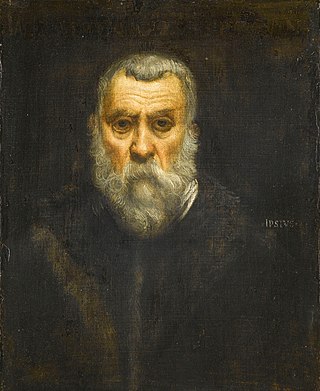
Jacopo Robusti, best known as Tintoretto, was an Italian Renaissance painter of the Venetian school. His contemporaries both admired and criticized the speed with which he painted, and the unprecedented boldness of his brushwork. For his phenomenal energy in painting he was termed il Furioso. His work is characterised by his muscular figures, dramatic gestures and bold use of perspective, in the Mannerist style.

Maundy, or Washing of the Saints' Feet, Washing of the Feet, or Pedelavium or Pedilavium, is a religious rite observed by various Christian denominations. The word mandatum is the first word of the Latin Biblical quotation sung at the ceremony of the washing of the feet: "Mandatum novum do vobis ut diligatis invicem sicut dilexi vos", from the text of John 13:34 in the Vulgate. The ceremony commemorates the commandment of Christ that his disciples should emulate his loving humility in the washing of the feet. The medieval Latin term mandatum, came to apply to the rite of foot-washing on the Thursday preceding Easter Sunday, known in English as "Maundy Thursday" since at least 1530.

Jacopo Bassano, known also as Jacopo dal Ponte, was an Italian painter who was born and died in Bassano del Grappa near Venice, and took the village as his surname. Trained in the workshop of his father, Francesco the Elder, and studying under Bonifazio Veronese in Venice, he painted mostly religious paintings including landscape and genre scenes. He often treated biblical themes in the manner of rural genre scenes, portraying people who look like local peasants and depicting animals with real interest. Bassano's pictures were very popular in Venice because of their depiction of animals and nocturnal scenes. His four sons: Francesco Bassano the Younger, Giovanni Battista da Ponte, Leandro Bassano, and Girolamo da Ponte, also became artists and followed him closely in style and subject matter.

Juan de Flandes was a Flemish painter active in Spain from 1496 to 1519. His actual name is unknown, although an inscription Juan Astrat on the back of one work suggests a name such as "Jan van der Straat". Jan Sallaert, who became a master in Ghent in 1480, has also been suggested. He worked in the Early Netherlandish style.

Leandro Bassano, also called Leandro dal Ponte, was an Italian artist from Bassano del Grappa who was awarded a knighthood by the Doge of Venice. He was the younger brother of artist Francesco Bassano the Younger and third son of artist Jacopo Bassano. Their father took his surname from their town of Bassano del Grappa, and trained his sons as painters.
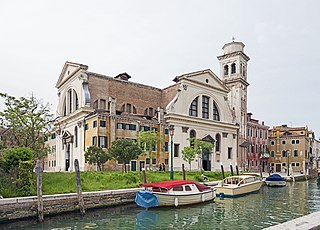
San Trovaso is a church in the sestiere or neighborhood of Dorsoduro in Venice, northern Italy.
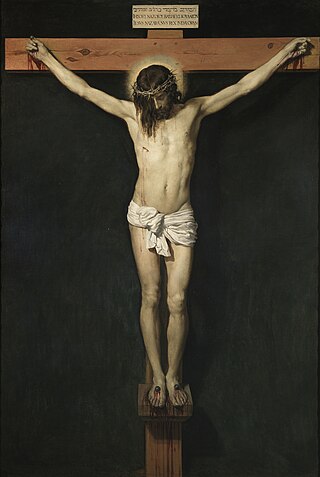
Christ Crucified is a 1632 painting by Diego Velázquez depicting the Crucifixion of Jesus. The work, painted in oil on canvas, measures 249 × 170 cm and is owned by the Museo del Prado.

The Miracle of the Slave is a painting completed in 1548 by the Italian Renaissance artist Jacopo Tintoretto. Originally commissioned for the Scuola Grande di San Marco, a confraternity in the city of Venice, the work has been held in the Gallerie dell'Accademia since 1815.

The Last Supper is a painting by the Italian Renaissance artist Jacopo Tintoretto. An oil painting on canvas executed in 1592–1594, it is housed in the Basilica di San Giorgio Maggiore in Venice, Italy.
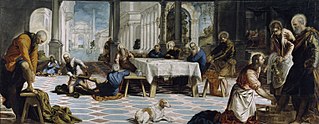
Christ Washing the Disciples' Feet was a favourite theme of Tintoretto, and there are at least six known works by him on the subject. The scene comes from a passage in John 13 where before the Last Supper Christ washes the feet of his disciples. This passage called for a complex image with many characters in a variety of poses and motions, and the diversity and challenge attracted Tintoretto. The paintings were commissioned for various churches of Venice, though since then four of the six have left Italy.
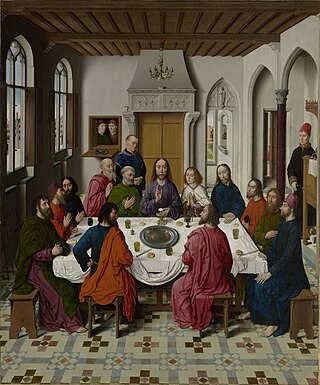
The Last Supper of Jesus and the Twelve Apostles has been a popular subject in Christian art, often as part of a cycle showing the Life of Christ. Depictions of the Last Supper in Christian art date back to early Christianity and can be seen in the Catacombs of Rome.
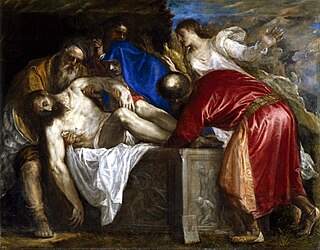
The Entombment is a 1559 oil-on-canvas painting by the Venetian painter Titian, commissioned by Philip II of Spain. It depicts the burial of Jesus in a stone sarcophagus, which is decorated with depictions of Cain and Abel and the binding of Isaac. The painting measures 137 cm × 175 cm and is now in the Museo del Prado in Madrid. Titian made several other paintings depicting the same subject, including a similar version of 1572 given as a gift to Antonio Pérez and now also in the Prado, and an earlier version of c.1520 made for the Duke of Mantua and now in the Louvre.

The church of San Marcuola is a religious building facing the Grand Canal and located in the sestiere of Cannaregio in Venice, Italy. It is dedicated to the saints Hermagoras and Fortunatus. Palazzo Memmo Martinengo Mandelli is a neighboring building.

Susanna and the Elders is a painting by the Venetian painter Tintoretto. Robusti, also known as Tintoretto or Il Furioso, for the energy and "fury" with which he painted, depicted both sacred and profane subjects in a period sometimes known as the Venetian “golden century”.

Annunciation is a 1570 painting by the Greek artist of the Spanish Renaissance El Greco, now in the Museo del Prado in Madrid. According to the art historian José Álvarez Lopera, it derives from an engraving by Jacopo Caraglio.

Ixion is a 1632 oil painting, signed and dated by Jusepe de Ribera. It shows a scene from Classical mythology, of Ixion being tortured as the eternal punishment meted out by Zeus. It is one of a series of four paintings by Ribera of the four "Furies" or "Condemned" from Greek mythology. It is held by the Museo del Prado in Madrid, along with Ribera's painting of Tityos; the other two, of Sisyphus and Tantalus, are lost.

Wedding at Cana also known as Wedding Feast at Cana and Le Nozze di Cana is an oil painting by Michael Damaskinos. He was active during the second half of the 16th century in Heraklion, Sicily, Venice, and different parts of Italy. Over 100 works are attributed to the artist. Most of his work resembled the Greek mannerisms prevalent at the time also known as maniera greca. He was clearly influenced by Venetian painting. His version of the Wedding at Cana was a copy of Tintoretto's massive painting of the Wedding Feast at Cana. The monumental canvas was 4.4 m x 5.9 m or 14.4 ft x 19.3 ft. The painting was originally in the dining hall (refectory) of the convent of the Crociferi in Venice. Refectories typically featured large paintings of biblical banquet scenes. The monks preferred biblical banquet scenes because they desired the impression of dining with Christ. Damaskinos probably saw the painting at the convent or a copy of the masterpiece in Venice. The Damaskinos version is much smaller than the original. The painting is very important because it is one of the few instances where Damaskinos broke from the traditional maniera greca prevalent in most of his works. In this instance, he strictly followed the lines of Venetian painting exhibiting his superior craftsmanship as a painter capable of changing his style. El Greco was another painter who also painted in both styles. The Damaskinos version is currently at the Museo Correr in Venice, Italy.





















